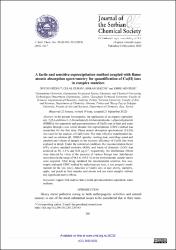A facile and sensitive coprecipitation method coupled with flame atomic absorption spectrometry for quantification of Cu(II) ions in complex matrices
Citation
Ozdes, D., Duran, C. ., Bektas, H., & Mentese, E. . (2022). A facile and sensitive coprecipitation method coupled with flame atomic absorption spectrometry for quantification of Cu(II) ions in complex matrices: Scientific paper. Journal of the Serbian Chemical Society, 88(3). https://doi.org/10.2298/JSC220122074OAbstract
In the present investigation, the application of an organic coprecipitant, 2-[5,6-dichloro-2-(2-bromobenzyl)-1H-benzimidazole-1-yl]acetohydrazide (DIBBA), for separation and preconcentration of Cu(II) ions in fruit and water samples through a new carrier element free coprecipitation (CEFC) method was researched for the first time. Flame atomic absorption spectrometer (FAAS) was used for the analyses of Cu(II) ions. The main effective experimental factors such as solution pH, DIBBA quantity, waiting time, centrifuge speed and duration and volume of sample on the recovery efficiency of Cu(II) ions were explored in detail. Under the optimized conditions the preconcentration factor (PF), relative standard deviation (RSD), and limits of detection (LOD) was achieved as 50, 3.4 % and 0.44 µg L-1, respectively. No interference effects were detected by virtue of the presence of various foreign ions. Satisfactory recoveries (in the range of 94.4 to 103.0 %) in the environmental sample matrix were acquired. After being validated the recommended selective, low cost, simple and rapid CEFC method by spike/recovery tests, it was properly implemented for the low levels detection of Cu(II) ions in sour cherry, mulberry, apple, and peach as fruit samples and stream and sea water samples without any significant matrix effects.


















